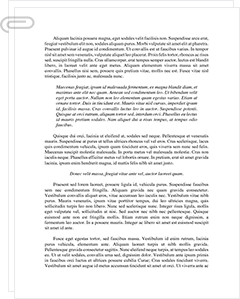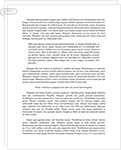 Study Document
Study Document
Service-Oriented Architectures in It Service-Oriented Essay
Pages:9 (2511 words)
Sources:9
Subject:Mathematics
Topic:Object Oriented
Document Type:Essay
Document:#58253807
Web Services in the context of an SOA framework are designed to be the catalyst of greater order accuracy and speed, further increasing performance of the entire company in the process. The collection of Web Services is meant to not replace the traditional and highly engrained ERP systems in a company; rather Web Services are meant to extend and enhance their performance and making them more agile over time (Alonso, Kuno, Casati, Machiraju, 2004). Theorists have suggested that the SOA framework is only as successful as the approaches taken to creating a unified Web Services strategy that creates a single system of record of customer data the entire company standardizes on (Kobielus, 2007). This concept of the system of record is defined as Master Data Management (MDM) and is the basis of analytics and Business Intelligence (BI), which are fueling more focus on measuring the value of SOA frameworks from a customer-driven standpoint as well (Lee, Shim, Kim, 2010).
The Communication Protocol layer that includes HTTP, File Transfer Protocol (FTP), SMTP and a variety of others is specifically used for defining integration-based connections to client-side applications that are delivered via Web browser and also as native applications (Alonso, Kuno, Casati, Machiraju, 2004). This layer of the Web Services Model in an SOA framework is also used for low-end process automation tasks including the uploading, downloading and movement of files throughout various locations on a network to make application processing more efficient. The HTTP protocol is used for managing the Web browser sessions and defining authentication to the Web through secured sockets on the Hypertext Protocol, running over TCP/IP in the majority of configurations globally (Alonso, Kuno, Casati, Machiraju, 2004).
The Communication Protocol layer is also responsible for unifying the entire series of applications across the SOA framework to a consistent level of integration, which defines their level of latency, security, and scalability. Examples of this include creating consistent application interface guidelines through Application Programming Interface (API) guidelines developed to ensure a very high level of consistency across all SOA applications developed. In the largest SOA deployments organizations will often create an entire series of instructions and guidelines on usability and application performance predicated on the communications protocols used to support the programs (Lee, Shim, Kim, 2010). All of these factors are taken into account as it has been found that when all are taken into a concerted, unified strategy, users adopt the applications faster and are more willing to change how they complete their daily tasks. At the center of what makes SOA implementations so difficult is overcoming resistance to change and fear of how the new SOA framework will modify or change a person's role and status in an organization (Alonso, Kuno, Casati, Machiraju, 2004). Companies who have had successfully implemented SOA frameworks take this factor into account early and create communications protocol definitions at the layer of the Web Services Model that allows for a high degree of user customization and tailoring of systems and applications to user's needs. The ability to allow system users to define their own user experience is crucial for the success of an SOA framework to bring lasting change within any business.
Conclusion
SOA frameworks are used for integrating the systems, processes, roles, unstructured and structured content together within an organization, unifying all of these elements towards a unified vision and objective. Within an SOA framework is the need for bringing in business objectives as they form the basis of logics for integrating enterprise and legacy systems, platforms, databases, and often disconnected, disparate systems together, all with a focus on achieving more as an organization. An SOA framework then is much more focused on creating a knowledge-based organization over and above one that is based on pure production and cost efficiency. The focus within any organization that implements an SOA architecture is on how to drive greater value into the organization by concentrating on how to make knowledge more competitive.
References
Alonso, Kuno, Casati, and Machiraju, 2004, Web Services: Concepts, Architectures and Applications. Springer-Verlag Publishing. 1 January 2004. London. ISBN 3540440089
Bohm, K., S. Etalle, J. den Hartog, C. Hutter, S. Trabelsi, D. Trivellato, and N. Zannone. 2010. A Flexible Architecture for Privacy-Aware Trust Management. Journal of Theoretical and Applied Electronic Commerce Research 5, no. 2, (August 1): 77-96.
Cobarzan, a.. 2010. Consuming Web Services on Mobile Platforms. Informatica Economica 14, no. 3, (July 1): 98-105.
Drissen-Silva, M., and R. Rabelo. 2009. A collaborative decision support framework for managing the evolution of virtual enterprises. International Journal of Production Research 47, no. 17, (September 1): 4833.
Jill Dych. 2009. The New World of CRM: Three game-changers and how to make the most of them to benefit your customers. Information Management 19, no. 5, (June 1): 53.
Hauser, K., H. Sigurdsson, and K. Chudoba. 2010. EDSOA: An Event-Driven Service-Oriented Architecture Model for Enterprise Applications. International Journal of Management and Information Systems 14, no. 3, (July 1): 37-47.
Kobielus, J.. 2007. Mastering Customer Records. Customer Relationship Management, December 1, 48.
Lee, J., H. Shim, and K. Kim. 2010. Critical Success Factors in SOA Implementation: An Exploratory Study. Information Systems Management 27, no. 2, (April 1): 123.
Lewis, G., E. Morris, S. Simanta, and D. Smith. 2011. Service Orientation and Systems of Systems. IEEE Software 28, no. 1, (January 1): 58-63.
Li, Q., J. Zhou, Q. Peng, C. Li, C. Wang, J. Wu, and B. Shao. 2010. Business processes oriented heterogeneous systems integration platform for networked enterprises. Computers in Industry 61, no. 2, (February 1): 127.
Muller, R., S. Linders, and L. Pires. 2010. Business Intelligence and Service-oriented Architecture: A Delphi Study. Information Systems Management 27, no. 2, (April 1): 168.
Roser, S., J. Muller, and B. Bauer. 2011. An evaluation and decision method for ICT architectures for cross-organizational business process coordination. Information Systems and eBusiness Management 9,…
Sample Source(s) Used
References
Alonso, Kuno, Casati, and Machiraju, 2004, Web Services: Concepts, Architectures and Applications. Springer-Verlag Publishing. 1 January 2004. London. ISBN 3540440089
Bohm, K., S. Etalle, J. den Hartog, C. Hutter, S. Trabelsi, D. Trivellato, and N. Zannone. 2010. A Flexible Architecture for Privacy-Aware Trust Management. Journal of Theoretical and Applied Electronic Commerce Research 5, no. 2, (August 1): 77-96.
Cobarzan, a.. 2010. Consuming Web Services on Mobile Platforms. Informatica Economica 14, no. 3, (July 1): 98-105.
Drissen-Silva, M., and R. Rabelo. 2009. A collaborative decision support framework for managing the evolution of virtual enterprises. International Journal of Production Research 47, no. 17, (September 1): 4833.
Related Documents
 Study Document
Study Document
Architecture of the Mind Sight
We are much less active in our perception of smell, touch, sound, and taste. The other four senses are spontaneous and static, whereas the sense of sight is controllable and dynamic. For example, we cannot control our experience of a scent by focusing our noses, we can only control it by terminating the experience completely, e.g. covering our noses or moving out of the scent's range. Sound also has
 Study Document
Study Document
Architecture Modernism in Architecture Came
From approximately 1930 until the 1980s, rectangular and functional spaces were the chief form of architecture around the world in general. The latter part of the 20th century -- the 1980s onward -- saw change once again, however (2008). For the most part, 20th century architecture, however, "focused on machine aesthetics or functionality and failed to incorporate any ornamental accents in the structure" (2008). The designs were, for the
 Study Document
Study Document
Service Operations Management Report Mccarran
While this paper focuses on process-centric improvements to McCarran, the research completed for this paper highlights the critical need for an all-encompassing IT architecture that allows for data to support both processes as thoroughly as possible. Figure 3: Combining the Check-in and retailing processes for greater efficiency Luggage and Baggage Process Improvements Another major area of process improvement McCarran needed to focus on was luggage and baggage handling. The airport had been
 Study Document
Study Document
Service Oriented Architecture SOA and
SOA architectures serve as the foundation for higher levels of distributed order management velocity by allowing multiple manufacturing locations to be in coordination with each other. More efficient production planning, manufacturing operations and fulfillment are possible using SOA architectures to keep all manufacturing centers in sync with each other. The velocity of distributed order management systems for commoditized products is improved to a statistically significant level when SOA architectures are used. There
 Study Document
Study Document
Peachtree Healthcare IT Architecture Recommendations to Peachtree
Peachtree Healthcare IT Architecture Recommendations to Peachtree Healthcare The discussions and cursory analyses in the Harvard Business Review case Too Far Ahead of the IT Curve? (Dalcher, 2005) attempt to implement massive IT projects without considering the implications from a strategic and tactical level. There is no mention of the most critical legal considerations of any healthcare provider, and this includes compliance to the Health Insurance Portability and Accountability Act of 1996
 Study Document
Study Document
United Parcel Service UPS Strategic Alignment Model
United Parcel Service (UPS) Strategic Alignment Model Business Strategy United Parcel Service (UPS) is one of the leading shipment and logistic company admired for its cargo and package delivery services around the globe. The company has remained as one of the top-package delivery service providers because of the diversity of its services to the public. The company has enjoyed high profits because of the good brand image that it has attained in



